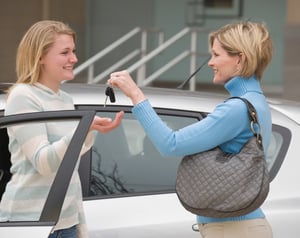 Both my daughters easily passed their driver's test. Their dad must have been a good instructor. At the time, they loved their newfound freedom. Sometimes, a bit too much! I constantly reminded them that we must continue working together to develop their driving skills. Unfortunately, it's a fact: teenage drivers account for more auto accidents than any other age group.
Both my daughters easily passed their driver's test. Their dad must have been a good instructor. At the time, they loved their newfound freedom. Sometimes, a bit too much! I constantly reminded them that we must continue working together to develop their driving skills. Unfortunately, it's a fact: teenage drivers account for more auto accidents than any other age group.
It’s easy to become complacent after your teenager gets their license. We've spent months riding around with them, teaching them the rules of the road. Why would we want to continue with those stressful and aggravating situations? Parental involvement is a crucial way to help educate and protect them.
Here are some topics I’ve discussed with them. I hope you find them helpful.
1. Teen/defensive driving schools. A typical behind the wheel driver’s education class teaches the rules of the road and basic driving skills. Advanced driving school programs, such as Road America’s teen driving school focus on skills not taught in driver’s education including:
- Skid control and recovery;
- Braking and emergency lane changes;
- Proper vision skills; and a
- Variety of other fundamental car control drills.
Both my daughters participated in this class and loved it. They told me they learned so much and feel even more confident on the road. You're eligible for discounted rates if you’re a West Bend Home and Highway policyholder.
2. Weather. Different weather conditions can affect how we drive. Rain, sleet, and snow affect traction and braking. What may be common sense to us may not be for new teen drivers. Before letting them drive in a new weather condition, take them somewhere safe where you can talk and they can practice new driving techniques.
3. Animals. This time of year, animals are on the move. Deer hits are prevalent in Wisconsin. If an animal runs out, instinct is to swerve to avoid hitting it. I constantly remind my daughters to brake hard and fast if possible; never swerve for an animal. Swerving to avoid hitting an animal can put your teen driver and others into potentially deadly situations.
4. Intersections. Unfortunately, many drivers who get a yellow or red light speed up instead of slowing down. This tip is critical for new and experienced drivers alike. Always check the intersection to make sure it’s clear before proceeding on a green light. During a practice session with my daughter, I had just uttered those words, and another driver went through a red light while ours was green. A second sooner, my daughter probably would’ve been taken to the hospital.
5. Clean windshield. Trying to look through a dirty or snow-covered windshield can be dangerous. Light reflecting off a dirty or frosty windshield during sunrise and sunset can make it extremely difficult to see. When the first frost glazes their windshield or the first snowfall buries their car, show them how to clean it properly. Again, what’s common sense to you may not be to your teen.
6. Roadside assistance. If you don’t have it, consider purchasing roadside assistance for your family. A dead battery or a flat tire can be a nuisance for adults. For a new teen driver, it can be a scary situation. Moreover, with increased highway speeds, staying in your car is best. And wait for a professional’s assistance.
7. School parking lot. Depending on the size of your high school, the parking lot before and after school can be chaotic. A few extra minutes before and after can make a big difference in avoiding congestion and fender benders.
8. Car accidents. Teens are three times more likely to have an accident per mile driven than adults are. Inexperience behind the wheel is the leading cause. While we hope our teens are not involved in accidents, statistics say otherwise. Discussing what to do after an accident can be helpful for both of you. I’ve already received a phone call from my daughter asking me what to do because she was rear-ended at a stoplight by another student. Luckily, it was just a bump, and there wasn’t any damage. Unfortunately, trying to have a conversation over the phone just after it happened was difficult for us. Planning can make dealing with the first accident a bit easier.
9. Car inspections. Periodically look at their car tires and instrument panels. I’ve explained to my daughters what to watch for but learned that sometimes indicator lights are overlooked.
10. Purchase an app. Smartphone apps are available that monitor driving behaviors and send automatic text messages when teens arrive safely at their destinations. This is an excellent opportunity to monitor their driving and offer additional teaching opportunities.
11. Graduated driver-licensing systems. These systems are designed to progress new drivers through different scenarios over time. Become familiar with your state’s program.
12. Recalculating. Driving to school, a part-time job, or a friend’s house can take new drivers through parts of your city that they’re unfamiliar with or that may present a challenging driving situation. For example, making a left-hand turn at a busy intersection that doesn’t have a green arrow can be tricky. If either scenario occurs, consider talking to them about finding an alternative route. The next time you’re driving together, guide them on navigating through a situation that’s new to them.
For additional resources, check out my blogs below.
School parking lot safety tips
Summer driving danger and your teenager
Ten tips to avoid distracted driving
Vehicle warning lights and their meanings [Infographic]
Do you have any suggestions or information you’d like to share? I’d love to hear from you. Please share them in the box below.





